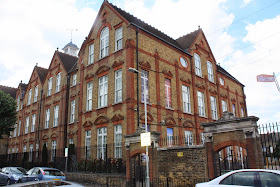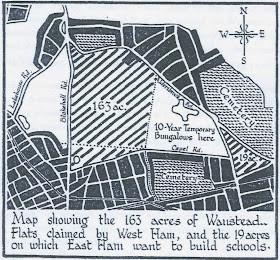The blog is based on a recently self published book by local author and publisher, Paul Holloway, which consists principally of the letters from Jack that his grandmother (May Larby) kept, during the less than two years of their relationship. Details of the book, and its availability appear in the footnote, below.
 |
| Lt John "Jack" Richardson, 1915 |
The previous episode ended with Jack's departure to France, on 17 March 1915, some nine months after volunteering for action, and eight after the outbreak of hostilities.
The reality is, however, at this time, the average allied forces' officer only survived six weeks on the front line, before death struck - Jack managed seven.
Jack, like most of his contemporaries, could not wait for action, and was frustrated at the delays he had experienced. He viewed the prospect of the front line, if not with relish, certainly with eager anticipation.
It is now mid March 1915, and Jack's first letter from the trenches is received. For understandable security reasons, the exact location is not identified. The tone is cheerful. Clearly the war is on, work is to be done, but all seems well.
"I came to the trenches for four days last night about 6.30. We marched along a railway line, then a road with just one or two bullets whistling here and there but with no casualties.. ... The Germans giving us quite a rifle bombardment at 'reveille'. They keep this up more or less all night. ... It's such lovely weather today and the fellows here are jolly decent. I've even begun sketching the ruined houses etc. ...
"We stay here in the trenches 4 days and then have 4 in the billets. The latter are quite nice and we live in comparative luxury, although the shells come quite close and knock the corners off houses and break windows."
"There is very little danger here and I am thoroughly enjoying myself. The business doesn't seem nearly so horrible now that I am here. I'm in that frame of mind which is prepared to take the whole thing as a game, and a good one too."
The message by 23 March is still upbeat: "We had a 'working party' too last night and in front of the trench parapet throwing up earth to strengthen it. It's rather exciting for the enemy send up rockets and star shells and light up the whole scene. Then we have to drop down until everything is dark again. However there isn't much real danger and its jolly good exercise."
But the mood soon changes. The next day's letter reports: "The trenches are some 4 or 5 inches deep in mud and you can't distinguish the shape of our boots for the mud round them and my puttees are caked in it up to the knees".
"However, none of us will be sorry to see the end of the war - this life is jolly interesting and exciting for a time, but after a few months I should think it becomes well nigh unbearable and monotonous".
 |
| Jack Richardson's Memorial Scroll |
"Here and there is a house with great holes in the walls or roof, where a German shell has landed; and the Town Hall clock looks down on you with half its face blown away. It is, at night, absolutely a town of the dead - a city of dreadful night and the guns boom all the time"
"I have never felt death so omnipresent before ... We shelled the Germans as they left the town a month ago. There was house to house fighting, to force them out, and the fields outside must be sown with corpses. May, the war must end before the summer. And everywhere, during the day, outside the town where we are in the trenches it is one incessant scream and whistle of bullets and shells and at night absolute silence between the booming of the heavy guns and the bursts of rifle fire and the machine guns."
And then, for a while, the letters are less graphic. Perhaps conditions improved, more likely Jack did not wish to depress May with his observations. But the letters kept coming, reflecting once more on their shared cultural interests, or often detailing the more mundane aspects of life in a foreign country. That, and hopes for the future, when the two long for their reconciliation, that tragically will not occur.
 |
| Jack Richardson's medal entitlement |
"As a result I am now in hospital for a day or two, in order to get my hand cleaned of the grit and little splinters ... I expect to be quite capably left-handed again in a day or two.... At present of course, my hand has a plum pudding appearance, but in all I should think there is hardly a dozen small cuts and scratches, though much bandage."
His hand is still recovering five days later, but Jack is still able to show what a small world even that of warfare is, when recounted to May: "I met an old Shaftesbury Boy in the street here - in the RAMC (Royal Army Medical Corps) - and he tells me that Hudson (do you remember him at the Tech?) is in billets in the town. I am going to seek him out."
| University Roll of Honour and Roll of Fallen |
He was, of course, completely unable to predict his final demise, but the closing paragraphs of his last letter almost seemed designed to offer reassurance to May, in what are clearly extremely difficult conditions "Yesterday night the Germans managed to drop three shells, out of some fifteen fired, into our trench, but the damage was slight and there were no casualties. These are awfully good trenches and will stand any amount of shell fire.
"While the weather lasts, I think, on the whole, I would rather be in the trenches than in billets. I scarcely ever sleep comfortably in town because I expect to be called up with an alarm every night I hear the gunfire; here the guns boom all night, and one doesn't notice it."
"My beloved, these days of sunshine make me feel only a matter of weeks or a month or so before I see you again - I dream of it at night"
Sadly, it was not to be. On Sunday 25 April 1915 Jack was wounded having been reconnoitring in front of his trench, at night, with his sergeant. He died of these wounds on Friday 7 May 1915, aged 22.
Thus, a young and local life, with someone with hopes and real aspirations for a bright future came to a tragically premature end. It was the fate of 16 million other young men of the age, in the 'war to end all wars', which effectively recommenced just 20 years later.
 |
| Jack is buried at Ferme Butene military cemetery , Houplines - 2 kilometres from Armentieres. It was used as a war cemetery from January - October 1915 and contains 129 Commonwealth losses |
Footnote: There Are No Flowers Here - Collected Letters of Jack Richardson, published by My Fat Fox priced £9.29 (inc p&p), from Amazon. We are most grateful for Paul for permission to run these extracts and recommend his collection of letters to you - they put local flesh on the bones of some of the raw data that is published about World War 1.










.jpg)










